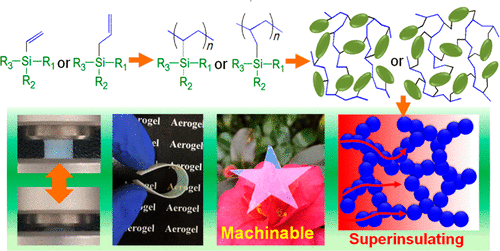当前位置:
X-MOL 学术
›
Chem. Mater.
›
论文详情
Our official English website, www.x-mol.net, welcomes your
feedback! (Note: you will need to create a separate account there.)
Versatile Double-Cross-Linking Approach to Transparent, Machinable, Supercompressible, Highly Bendable Aerogel Thermal Superinsulators
Chemistry of Materials ( IF 7.2 ) Pub Date : 2018-04-01 00:00:00 , DOI: 10.1021/acs.chemmater.8b00563 Guoqing Zu 1, 2 , Kazuyoshi Kanamori 1 , Taiyo Shimizu 1 , Yang Zhu 1 , Ayaka Maeno 3 , Hironori Kaji 3 , Kazuki Nakanishi 1 , Jun Shen 2
Chemistry of Materials ( IF 7.2 ) Pub Date : 2018-04-01 00:00:00 , DOI: 10.1021/acs.chemmater.8b00563 Guoqing Zu 1, 2 , Kazuyoshi Kanamori 1 , Taiyo Shimizu 1 , Yang Zhu 1 , Ayaka Maeno 3 , Hironori Kaji 3 , Kazuki Nakanishi 1 , Jun Shen 2
Affiliation

|
A facile yet versatile approach to transparent, highly flexible, machinable, superinsulating organic–inorganic hybrid aerogels is presented. This method involves radical polymerization of a single alkenylalkoxysilane to obtain polyalkenylalkoxysilane, and subsequent hydrolytic polycondensation to afford a homogeneous, doubly cross-linked nanostructure consisting of polysiloxanes and hydrocarbon polymer units. Here we demonstrate that novel aerogels based on polyvinylpolysilsesquioxane (PVPSQ), polyallylpolysilsesquioxane (PAPSQ), polyvinylpolymethylsiloxane (PVPMS), and polyallylpolymethylsiloxane (PAPMS) are facilely prepared via this approach from vinyltrimethoxysilane (VTMS; or vinyltriethoxysilane, VTES), allyltrimethoxysilane (ATMS; or allyltriethoxysilane, ATES), vinylmethyldimethoxysilane (VMDMS), and allylmethyldimethoxysilane (AMDMS), respectively. These aerogels combine low density, uniform nanopores, high transparency, supercompressibility, high bendability, excellent machinability, and thermal superinsulation (λ = 14.5–16.4 mW m–1 K–1). More importantly, transparent, superflexible, superinsulating aerogels are obtained with PVPMS and PAPMS via highly scalable ambient pressure drying without any solvent-exchange and modifications for the first time. This work will open a new way to transparent, highly flexible porous materials, promising in the practical applications of thermal superinsulators, adsorbents, sensors, etc.
中文翻译:

透明,可加工,超压缩,高度弯曲的气凝胶热超级绝缘体的多功能双交联方法
提出了一种简便而通用的方法来制备透明,高度柔性,可加工,超绝缘的有机-无机混合气凝胶。该方法涉及单个烯基烷氧基硅烷的自由基聚合以获得聚烯基烷氧基硅烷,随后进行水解缩聚以提供由聚硅氧烷和烃聚合物单元组成的均质,双交联的纳米结构。在这里,我们证明了通过乙烯基三甲氧基硅烷(VTMS;或乙烯基三乙氧基硅烷,VTES),烯丙基三甲氧基硅烷(ATPS),乙烯基三甲氧基硅烷(VTMS;或乙烯基三乙氧基硅烷,VTES),基于聚乙烯基聚倍半硅氧烷(PVPSQ),聚烯丙基聚倍半硅氧烷(PAPSQ),聚乙烯基聚甲基硅氧烷(PVPMS)和聚烯丙基聚甲基硅氧烷(PAPMS)的新型气凝胶很容易制备。烯丙基三乙氧基硅烷(ATES),乙烯基甲基二甲氧基硅烷(VMDMS)和烯丙基甲基二甲氧基硅烷(AMDMS),分别。这些气凝胶结合了低密度,均匀的纳米孔,高透明性,超压缩性,高弯曲性,出色的机械加工性和热绝缘性(λ= 14.5–16.4 mW m–1 K –1)。更重要的是,使用PVPMS和PAPMS可以通过高度可扩展的环境压力干燥获得透明,超柔和超绝缘的气凝胶,这是首次无需进行任何溶剂交换和改性。这项工作将为透明,高柔韧性的多孔材料开辟一条新途径,有望在绝热超级绝缘体,吸附剂,传感器等的实际应用中大放异彩。
更新日期:2018-04-01
中文翻译:

透明,可加工,超压缩,高度弯曲的气凝胶热超级绝缘体的多功能双交联方法
提出了一种简便而通用的方法来制备透明,高度柔性,可加工,超绝缘的有机-无机混合气凝胶。该方法涉及单个烯基烷氧基硅烷的自由基聚合以获得聚烯基烷氧基硅烷,随后进行水解缩聚以提供由聚硅氧烷和烃聚合物单元组成的均质,双交联的纳米结构。在这里,我们证明了通过乙烯基三甲氧基硅烷(VTMS;或乙烯基三乙氧基硅烷,VTES),烯丙基三甲氧基硅烷(ATPS),乙烯基三甲氧基硅烷(VTMS;或乙烯基三乙氧基硅烷,VTES),基于聚乙烯基聚倍半硅氧烷(PVPSQ),聚烯丙基聚倍半硅氧烷(PAPSQ),聚乙烯基聚甲基硅氧烷(PVPMS)和聚烯丙基聚甲基硅氧烷(PAPMS)的新型气凝胶很容易制备。烯丙基三乙氧基硅烷(ATES),乙烯基甲基二甲氧基硅烷(VMDMS)和烯丙基甲基二甲氧基硅烷(AMDMS),分别。这些气凝胶结合了低密度,均匀的纳米孔,高透明性,超压缩性,高弯曲性,出色的机械加工性和热绝缘性(λ= 14.5–16.4 mW m–1 K –1)。更重要的是,使用PVPMS和PAPMS可以通过高度可扩展的环境压力干燥获得透明,超柔和超绝缘的气凝胶,这是首次无需进行任何溶剂交换和改性。这项工作将为透明,高柔韧性的多孔材料开辟一条新途径,有望在绝热超级绝缘体,吸附剂,传感器等的实际应用中大放异彩。











































 京公网安备 11010802027423号
京公网安备 11010802027423号